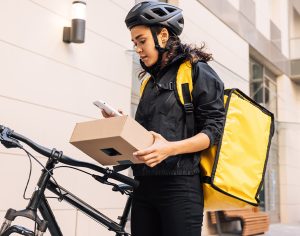Photo credit: Amazon
Drone delivery has been a hot topic for years. Few companies embody the drive towards using commercial unmanned aerial vehicles (UAV) like Amazon does. The e-commerce giant has been championing the method and developing its own technology to make it a reality for years. During its re:MARS conference it unveiled its newest drone, promising to start using it for deliveries within months. However, experts are sceptical that the technology will become commonplace anytime soon.
The new version of the drone can fly up to 15 miles thanks to its six propellers. Amazon claims the airborne robot will be able to deliver packages weighing up to 5lbs (2.3kg) within 30 minutes. The device will utilise AI to spot moving objects like dogs and helicopters as well as static ones like chimneys and clothes lines.
Amazon also announced it would begin to use the drone to deliver packages within months. While the tech titan was unclear as to where exactly this would happen, the BBC reported that the US Federal Aviation Administration has granted Amazon a special permission to use the drone in authorised areas. The tech giant has previously conducted trials in Cambridgeshire and is seemingly looking for a new drone operator to test this new iteration of the technology, according to Cambridgeshire Live.
Of course, Amazon isn’t alone in championing drones. Everyone from Domino’s Pizza to 7-Eleven have tested using UAVs to send goods to customers. And those are only the ones that reaches for the skies. Around the world startups are developing ground-based delivery robots. In fact, UK-based scaleup Starship Technologies’ robot shares a striking resemblance with Amazon’s own version named Scout.
It’s easy to see why there is a lot of buzz around this sector. “The major change that is going to happen thanks to the advancement of drone delivery will be that for the first time, it will be quicker to receive a delivery than to go out to the shop and get it yourself,” says Naji El-Arifi, head of innovation at Wunderman Thompson Commerce, the e-commerce consultancy. For instance, he argues that it could have massive ramifications for local producers, such as farmers, who could use drones to get better relationships with their consumers. “For food delivery companies such as Deliveroo, drone delivery would completely disrupt that market getting rid of the need for a certain percentage of those riders,” says El-Arifi. UAVs could also be used to map out countrysides or inspect buildings as well as a slew of other uses that would reduce the need to put humans at risk.
Despite the potential benefits, it seems unlikely that using UAVs to deliver packages will become widespread anytime soon. And, as in the case of both self-driving cars and e-scooters, British laws are the main obstacle. “Current UK legislation stipulates how far up a drone can fly, how close to crowds and that the pilot must maintain visual contact with the drone at all times,” says Karen Holden, the founder of A City Law Firm and guest speaker at #DroneCon2019. “This undoubtedly limits their potential commercial uses.”
The legislation also stipulates where drones can fly. UAVs are restricted from flying within 50 metres of crowds or 150 metres to individual people and properties. Drones are also banned from flying near prisons, nuclear sites and airfields.
And the laws are getting stricter after Gatwick Airport was forced to cancel hundreds of flights in December 2018 after a drone was spotted in the area. Following a consultation with the public, UAVs have been prohibited to fly within five kilometres of an airfield as of March 2019. That’s up from one kilometre under the old regulations.
Of course, as the technology keeps evolving and become safer, tech companies like Amazon are likely to lobby regulators to loosen up the laws, enabling drone deliveries. “[Perhaps] in the not so distant future, we may see drone deliveries starting to occur within the UK, but as we also know the law takes time to catch up to emerging technology,” continues Holden.
But when it actually starts to roll out, it may not be in the centre of London. “The main thing we expect to see in the beginning for drone deliveries is that they will start in rural areas – places where it will be easy to land and take off and where it makes more sense to send a drone than a large tuck,” argues El-Arifi. “It will also be easier to test and ensure that all systems are in place in more rural areas where there are less obstacles.”
But before technology catches up to the point where regulators feel comfortable, the UK public can only hope to see Amazon’s new drone in action through confided trials. ![]()
Share via:








































